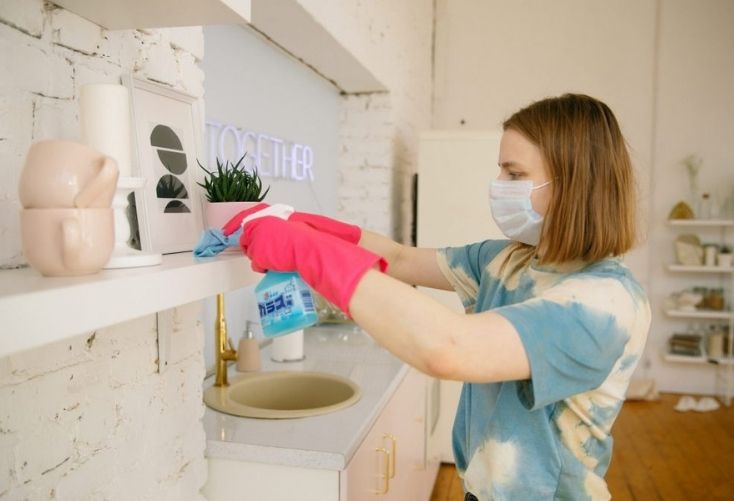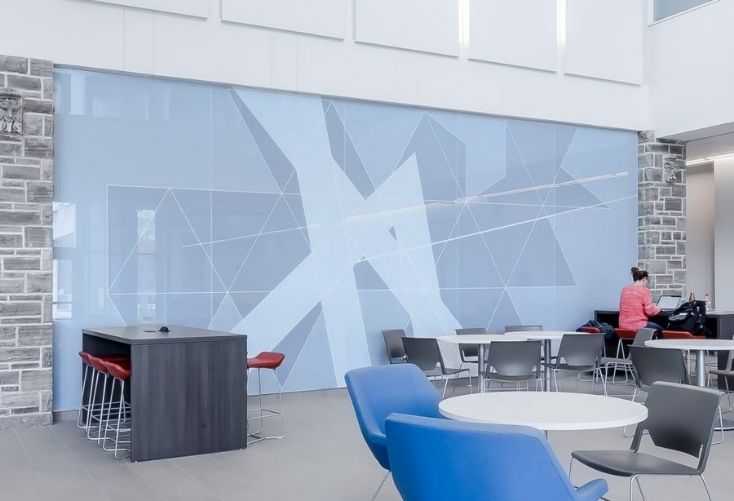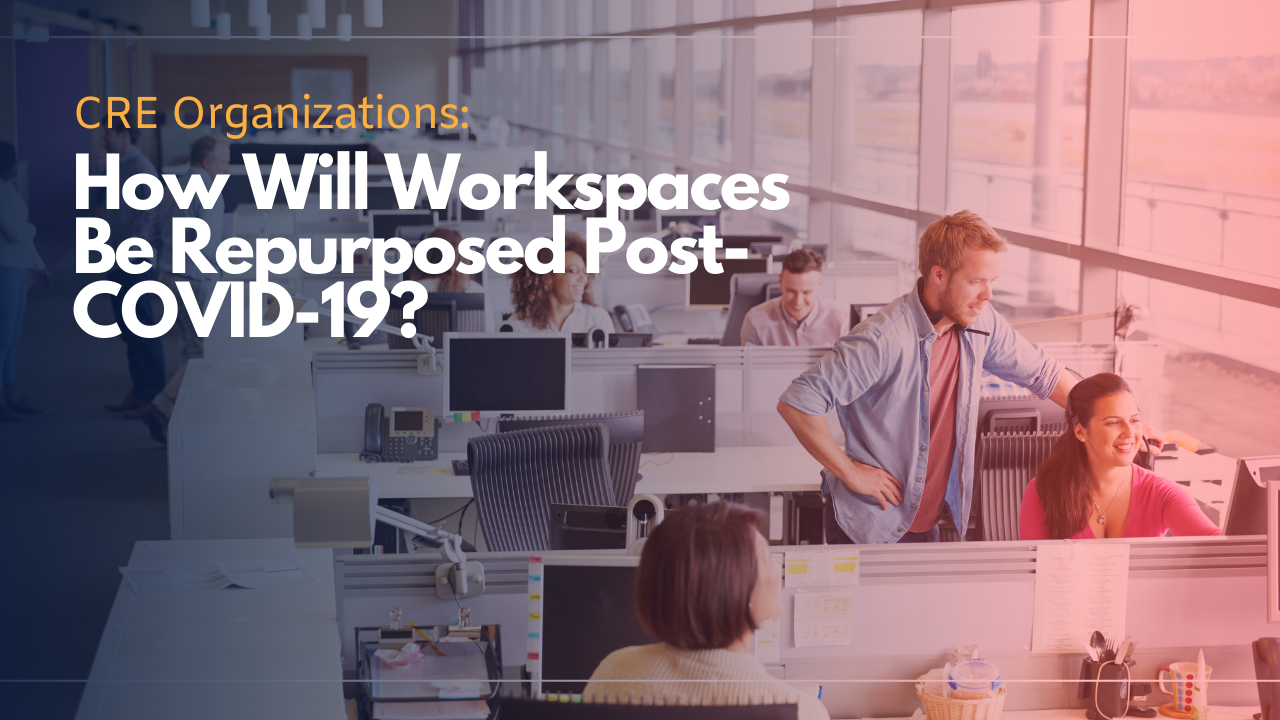- As companies resize and retrofit their real estate portfolios, how will their original workspace be repurposed?
- CRE companies JLL, Cresa, Cushman and Wakefield, and CBRE offer their insights.
- Among the observations put forward, there is now a much greater focus on the office as a place for human experience; rather than just showing up each day, tenants want social interaction and meaningful collaboration.
This article was originally published on Work Design Magazine.
How do CRE organizations think workspace will be repurposed as companies retrofit and resize their real estate portfolios? Check out the interesting points of view from JLL, Cresa, Cushman and Wakefield, and CBRE.
Imagine going on a road trip adventure with no particular destination in mind. If the COVID-19 pandemic has taught us anything is that we can expect the unexpected. While Carrie Fisher locked in on the title “Postcards from the Edge“, we borrowed the term and reached out to some of our savviest friends in the CRE community (listed at the end of this article) to send us a postcard about what they are seeing on their journey. We asked a few questions and got some interesting answers to share with our readers.
How are tenants planning to use their space differently?
Tenants are embracing robust work from home programs, with a projection of 12-30 percent of the workforce classified as remote workers long-term. For on-premise work, this means that spaces can ‘decompress’ as density goals shift from a Canadian average of 150 SF seat to about 200 SF per seat to accommodate physical distancing. There will also be a re-think of collaborative spaces and how they are structured. As we know, not only does physical distancing prevent COVID spread, but it also prevents common flu and cold spread.
Therefore, as a long-term solution to bolster productivity by preventing workplace sickness, tenants are looking at more open meeting spaces and less dense conference rooms. We have to solve acoustic issues for larger and more open meeting spaces, but there are systems already in production that can accomplish this by directing air flow and utilizing innovative ceiling materials. I expect more innovation in technology to support on-premise/off-premise collaboration, as well as innovation in materials and finishes that focus on anti-microbial surfaces. Long-term, we should see more innovation in building infrastructure: better HVAC systems, more touch free operations, operable windows or double skinned buildings, more elevators or escalators, single occupancy washrooms.
- Definite movement toward down-sizing space while implementing a reservation system (like our proprietary mobile application or the Work Design roundup here) in lieu of assigned seating
- Those that must be in the office have implemented interim social-distancing guidelines and innovative furniture components to provide actual and perceived safety
- Collaboration Areas are being expanded
- Food service / internal café / Break Rooms are currently closed
- Hearing lots of COVID weariness with many missing the collaboration with colleagues. My bet is by the end of the first quarter of 2021 we see some return to normalcy and typical workplace standards and uses
- Increased interest in UV Light and Ionization treatment of HVAC and increased janitorial costs
- Definitely seeing more space management and shift work through tools like our proprietary app vs making wholesale physical modifications. Most of my clients are not doing free address but using the tools to manage who can be in the office/lab/production area at any given time.
- Office space is now a resource and there is more focus on purpose for being in the office rather than just showing up each day.
- Lots of cleaning and PPE stations being added where none existed before
- Important to note that there is a difference between short term planning and long-term planning-
- In the short term, occupancy is primarily managed through reduced capacity, increased cleaning protocols, PPE available at the office, and close adherence to CDC protocol.
- Mid-Longer term, clients must evaluate the purpose of their office (for many It’s where collaboration, mentorship, and culture can be built). In this instance- many clients will look to use more of their square footage for shared spaces instead of dedicated workstations/offices. “We vs. Me space” as Steelcase puts it.
- Also Mid-longer term, with new and enhanced technology developed, space management systems, reservation apps or other tools will be more widely used, and companies will welcome the ability to make more data driven decisions around their space.
- Wellness (including a focus on both physical and psychological comfort) will become even more important.
- Many companies are going to embrace some sort of flexibility and may make work from home a more formal workstyle for employees. This will mean that companies are going to need to consider their space alongside their technology to create an intentional balance/inclusion for both in-office and remote employees.
The struggle is real! While many appreciate the experiment of work from home and can see the benefits of some of it, many are longing for more of a balance.
The pandemic has put remote working through an extraordinary test. It has also rapidly accelerated the pace of workplace transformation that would have otherwise taken years to materialize. This extreme shift has led many to query the role and purpose of physical offices. JLL research shows that 58 percent of the employees have missed their office substantially during lockdown. If remote working is here to stay, offices will find a new “raison d’être”. Companies will look to rationalize and aim for higher quality office spaces. Going to the office to work individually will not be a priority anymore. People will head to the office for an outstanding human experience – with their colleagues, managers, partners or clients – one that they are unable to experience remotely. The office will have to meet four main objectives:
- To support hyper collaboration;
- To encourage serendipity and creativity;
- To break physical barriers with the leadership and favor managerial proximity;
- And to become a social hub, where employees can share a common sense of purpose and live memorable moments, together and with their clients.
Individual work will be done at home and the office will enable people to collaborate and flourish both personally and professionally.

Across the board we are seeing demand for remote working even beyond COVID-19. This is leading occupiers to capitalize on the anticipated reduction of office use by reducing their office footprint. For a few, this means planning for less daily office occupancy as some jobs will remain 100 percent remote. However, for most companies, space reduction is more complicated because they’re planning for a ‘mixed presence’ approach that entails 2-3 days/week remote work and 2-3 days/week on-site work. ‘Free address’ occupancy strategies – meaning unassigned, shared seating – have become more popular as a solution to this hybrid demand.
We also are seeing occupiers reconsider the existential purpose of the office. In a pre-COVID world, the majority of employees came to the office every workday because it was expected. As employees imagine a world with more choice to work anywhere, they predict that their primary motivations for coming to the office will center around collaboration and team bonding. Focus and individual work, they say by contrast, is more productive at home. In response, occupiers are re-balancing space allocation away from individual desks and private offices towards more collaborative and social space to provide a better on-site experience.

What can landlords/owners do to re-purpose vacant space that may not be utilized for workspace in the near future? Long term?
Chair storage? Just kidding. Landlords should consider building out and furnishing vacant spaces that meet new guidelines for risk mitigation of COVID. They can act as an owner/operator of the spaces or hire a third party to manage it. Many companies will not have the capital to construct spaces and will seek to add those costs to their leases, rather than spend dollars up front. As well, if a landlord invests in strategies that increase the physical and psychological well-being as a focused strategy, i.e., creating a ‘healthy workplace’ then they will be leaps ahead of their competitors. If I were a landlord, I would invest in a strategy that raises my profile above others – and include sustainable interior finishes and furnishings. Modular wall systems could be used rather than drywall. These provide quick build times as they are manufactured offsite and can be reconfigured more easily. I would emphasize in a ‘made in Canada’ solution and choose flooring, walls, lighting, etc. that makes Canadians feel good about buying Canadian products.
- Unfortunately, I think we are still in a wait & see mode with occupants’ reluctance to return to the office there are not many options to re-purpose.
- As noted above, I believe the long-term includes a return to some form of prior normal – though with more flexibility of Work from Home policies
- Long term Landlords will need to make those spaces more appealing to the post-pandemic user by tempering the communal aspect of and adding more private, quiet car areas – social distancing will be around for a while
- It’s a good time for Landlords and Owners to evaluate pre-pandemic what some of the deficiencies of space were. Were employees constantly searching for meeting rooms? Quiet space?
- Even before the pandemic, workers had been more remote/distributed in general. Utilization studies were often resulting in the same statistics- employees are not at their individual workspace that much.
- Creating a variety of zones throughout the office for employees to accomplish different tasks will be beneficial.
- Even after the pandemic, video conferencing is likely here to stay in a much larger way – creating small areas where individuals can be on calls will be important. Many “Office Phone Booth” manufacturers are offering options with videoconferencing solutions built in
Given the depth of the transformation of offices, landlords will need to be smart and position themselves as partners and change agents.
They will have to provide more flexibility and choice. This will help their clients to redefine their real estate footprint and establish new hybrid models, with a combination of HQ, satellite offices, home-offices and coworking places.
They will also need to offer new human experience services. Vacant space can be used to deliver various amenities and services that cover well-being, sports, beauty, healthy food, etc. If employees go to the office less, they will look for highly personalized experiences when they do go to the office with an increased level of comfort. Health, and especially mental health, will become a top priority. Medical consultation rooms, physiotherapist and psychologists will be the type of services that people come to expect. This is where landlords can step in and add these services at a building or portfolio level.
Short-term, the need for on-going physical distancing means that most vacant space is being repurposed to allow occupiers to spread out and keep office density low. Long-term, as many occupiers contract their space, we predict that these vacancies will be transformed into multi-tenant amenity spaces or coworking spaces.
Common amenity choices include coffee bars, work lounges, conference centers, screening rooms, and fitness centers. Landlords and owners should consider the amenities provided in the surrounding area and seek to fill a gap or provide convenience. For inspiration, directly engage with your tenants to find out what would be most meaningful.

Transforming vacant office suites into coworking spaces is another potential solution. As hub-and-spoke models become more popular with tenants, we will likely see an uptick in demand for flexible spaces to accommodate smaller, distributed populations of employees.
Lastly, space expansion is still desirable for companies that have boomed through the pandemic. Several branches of the technology industry (e.g. – EdTech, E-commerce, Cybersecurity) and “essential fields” (e.g. – healthcare, food, logistics) may be looking for more space as they grow to meet demand. If these are atypical tenants for your asset(s), landlords and owners will need to reposition themselves to deliver competitive advantage in attracting these occupiers.
Tell us about anything that you have seen that is really creative, truly out of the box thinking when it comes to extra space usage? Can you share something about possible trends?
In Canada, it is too early to see tangible solutions, as the office real estate market has been frozen since March. To make vacant spaces and subleases more appealing to tenants, invest in GOOD DESIGN – which is a balanced approach considering the ECONOMY, ENVIRONMENT AND QUALITY OF LIFE. Before embarking on a design solution, a landlord should consider creating a DESIGN STRATEGY across properties. This includes developing a narrative and character for each property that makes it more desirable than other offerings in the neighborhood. It also helps for landlords to understand the demographics of the neighborhood from labor base to salary ranges as many companies are seeking to lease space near their workers rather than have their workers commute into a CBD. This ‘hub and spoke’ model will become important the longer the virus lasts. TTC reported an 86 percent percent decline in ridership as of July. This affects the occupancy of spaces. Savvy organizations will recognize this and provide solutions that are more distributed and still bring people together to foster innovation and collaboration – face to face – but six feet apart.

These are often fully glass so that there is not a loss of light or connectivity to other open areas around them (image source)
- We’ve seen a resurgence in build-out of short-term spec suites with a more socially distanced office arrangement
- Companies will need to create space for employees who may be remote but still coming in from time to time. Almost like a Business Lounge at an Airport or Hotel that is branded to the company- variety of seating, rooms, and plenty of access to technology where someone can meet or work alone. If the office is the place where collaboration is meant to thrive, the space and design must support it.
- Micro-offices – Enclosed small offices that are meant to be an individual space for heads-down work and meetings can happen in shared meeting spaces to promote moving throughout the office. These are often fully glass so that there is not a loss of light or connectivity to other open areas around them.
- Sub-architectural spaces – Clearly defined spaces in an open plan that offer more flexibility when creating collaboration/meeting space.
The adoption of remote work at scale will change space consumption and living habits. In the future, we will see new work-life balance, with more and more people moving outside of the city and looking for new third-party places, as an alternative to their home-office environment. These spaces will mean they benefit from the right professional environment while being anchored to a local working community.
Mixed-use buildings will enable people to work, live and consume in the same place. These buildings could offer fitness centers, urban farms, recycling centers, farmers markets, last-mile logistic centers, bike repair shops, autonomous stores, community spaces, concept stores, pet nurseries. The world of work needs to be re-evaluated and the sky is the limit!
The most creative use of extra space has been less about unique design features and more about the programming of the space with interesting services or events. Concerts, pop-up retail, networking events, food service, and concierge staff all have the potential to activate space and engage tenants and the community in ways that can truly differentiate an asset.
This approach follows a recent trend towards the ‘hotelification’ of the office experience to compete for attendance among a workforce with greater choice and latitude to work from a variety of places, including home. Operating more like high-end retail and hospitality can drive the type of curated experience that will help magnetize the office and entice users back into the space.
We want to thank our contributors from across the CRE realm. We look forward to sharing further insights as we work through managing the COVID-19 pandemic, its affect(s) on our industry and the journey to “What’s Next”. So far, the journey has been most interesting.
- Samantha Sannella, Managing Director, Strategic Consulting, Cushman and Wakefield
- Derek Snyder, Vice Chairman, Cushman and Wakefield
- Larry Kelso, Senior Vice President, Workplace Consultant and Program Manager at Cresa Dallas
- Kathy Thomas, Managing Principal, Project Management at Cresa Washington DC
- Gillian Baikie, Principal, Workplace Planning and Support at Cresa Denver
- Flore Pradère, Research Director for Corporate Solutions at JLL
- Marie Puybaraud, Global Head of Research for Corporate Solutions at JLL
- Lenny Beaudoin, Executive Managing Director, Space Enablement Services at CBRE


 Dr. Gleb Tsipursky – The Office Whisperer
Dr. Gleb Tsipursky – The Office Whisperer Nirit Cohen – WorkFutures
Nirit Cohen – WorkFutures Angela Howard – Culture Expert
Angela Howard – Culture Expert Drew Jones – Design & Innovation
Drew Jones – Design & Innovation Jonathan Price – CRE & Flex Expert
Jonathan Price – CRE & Flex Expert













